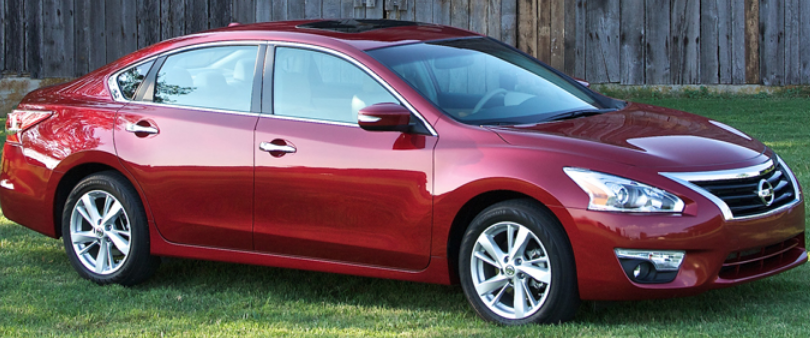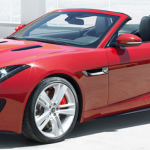
Note: This report supplements Consumer Guide Automotive’s full report on the 2013 Nissan Altima, a midsize sedan that starts at $21,500.
2018 New York Auto Show: 2019 Nissan Altima
Test car came equipped with: Carpeted floor and trunk mats as the sole factory option. Total MSRP with $780 destination charge = $28,745.
Powertrain: 270-horsepower 3.5-liter V6, continuously variable automatic transmission (CVT), front-wheel drive.
Acceleration: My colleagues give 4-cylinder Altima sedans a “6” for peppiness. I’d rate this V6 version at “7” or “8.” Our friends at Car and Driver clocked a 3.5 SV at 6.1 seconds 0-60 mph, which seems right to me.
I haven’t yet driven a 4-cylinder 2013 Altima, but I was really surprised by this V6/CVT version. I’ve never much liked belt-and-pulley transmissions, so I wasn’t expecting much from this one, yet it works as well as most conventional automatics. The torquey V6 plays a big role in that. Still, there was none of the noisy “speed lag” that occurs with most CVTs, which race the engine to high rpm and hold it there until momentum catches up or the driver backs off the throttle. Moreover, throttle response is satisfyingly quick, so you almost never want for passing thrust. I also like the manual mode with seven preset “gears,” selected from steering-wheel paddles. It’s hardly a new idea, but it is an unexpectedly sporty touch for a midsize family sedan. Better still, it works with mercury-switch speed and silkiness—better than some dual-clutch automated-manuals, in fact. Who knew?
Fuel Economy: We averaged 19.9 mpg in Phoenix-area driving with a fairly even city/freeway split. However, our time included a good many gas-eating cold starts and short hops. Considering that, plus the V6’s displacement and power, my result isn’t that bad. On the other hand, it’s over 2 mpg below the EPA city estimate. Happily, the engine uses regular-grade gas.
Ride Quality: The test car rolled on all-season Dunlop SP Sport 2000 AVS tires, size P235/45R18-94V. As the main-report intro notes, V6 Altimas have standard 18-inch rims instead of 16s or 17s like the four-bangers. I thought the ride was quite comfortable overall—a bit soft, almost “plush,” but nowhere near nautical. Even so, the car felt a bit “hard” much of the time, as if the tires were overinflated (which they weren’t). For now I’ll blame these particular tires.
Test Drive: 2016 Nissan Altima 2.5 SL
Steering/handling/braking: Altima isn’t designed to be a Euro-style sports sedan, but this V6 version comes close, thanks to a well-sorted chassis (those tires included) and the responsive powertrain. Though it’s more nose-heavy than 4-cylinder models and also exhibits mild body lean, it corners with the same predictable confidence—better really, as there’s more power for gunning through turns. I think this car would be good fun on demanding serpentine roads. Too bad I wasn’t able to test that theory. I second the main report’s comments about the fine steering and brakes, although this test car’s brake-pedal action was slightly touchy and unprogressive. A final plus is the virtual absence of torque-steer, at least in the warm, dry Arizona weather that prevailed during my test. (FYI, torque-steer is the tendency of many front-drive cars, especially potent ones, to veer left or right under power without the front wheels pointed straight ahead.)
Quietness: About as hushed as any class rival I’ve experienced lately. Yes, coarse-surface tire drone intruded here too, but I didn’t find it objectionable, and wind rush was low even in breezy weather. As ever, this Nissan 3.5 V6 is lovely, making a nice, fairly subdued snarl at high rpm and staying very much in the background otherwise. It really lends the whole car an almost premium-brand feel. The tester’s cloth upholstery helped too, as fabric absorbs noise, rather than reflecting it like leather.
Controls: My car lacked the optional navigation system, but the regular control scheme worked well enough for me. I can’t comment on phone-pairing or the streaming-audio features, as I’m certainly one of the few people left in this world who doesn’t (yet) own a smartphone, but I did have trouble making a few stereo adjustments. The climate controls are OK, but could be larger, more legible, and placed higher on the dashboard. I’ll rant here about another tedious, multi-step steering-wheel button for calling up trip-computer data (why do so many auto engineers seem to hate “back” buttons?) and a dashboard screen that not only washes out in moderate daylight but picks up major glare from the surrounding “piano black” trim. Last but not least, switches for trunk release, fuel-filler, traction-control off, etc., are buried on the left and hard to decipher. On the plus side, a little recess ahead of the shifter conveniently provides both a power point and a USB port.
Details: Don’t hold me to this, but I think V6 Altimas may have the same interior décor as equivalent four-pot models. If that’s so, it’s a letdown. Considering the massive $3,680 base-price difference in SV trim, the V6 cabin should have at least a few unique touches. That aside, I agree with the main report here, particularly about the cloth upholstery. It does feel good—sorta like a teddy bear—but looks ordinary, a shame when the V6 engine gives the car such a premium vibe. Let’s hope the fabric proves sturdy. The test car’s interior was also rather mass-market monochrome (boringly beige), but was saved from rent-a-car mediocrity by the various accents and broad soft-touch surfaces.
Room/comfort (front): I thought lumbar support was too much, or at least in the wrong place for my anatomy. As it was, it felt as if a lump in the seatback was pushing me forward. As for visibility, this 6-footer found it necessary to elevate the driver’s seat a bit, mostly owing to the highish side-window line, but even then the aft and rear-quarter views were just OK. Meantime, lifting myself up, as it were, reduced headroom beneath the included sunroof, though no hair-do was harmed in the making of this report.
Room/comfort (rear): As in so many cars, rear room and accessibility depend a lot on where the front seats are. “Sitting behind myself” felt a tad crowded, and footwell space in that condition was only just enough for threading in my size-10s. I wonder about long-haul seat comfort, as the rear bench looks rather flat and its backrest is raked too much for my taste.
Cargo room: Rear door pockets are just stylized bottleholders and that the deep in-dash glovebox is larger than most but less useful than it looks.
CP Says . . . The redesigned 2013 strikes me as the best Altima yet. Again, I don’t know how noisy the 4-cylinder models may be, but at least they deliver great fuel economy. The V6 versions are thirstier, of course, but also quicker and impressively refined. They’re almost posh enough for Nissan’s upscale Infiniti brand. Indeed, the 2013 Altimas even look a bit like Infiniti’s M sedans, especially the rear roof line.
Though a 4-cylinder test drive might change my mind, this V6 experience suggests the new Altima is a worthy overall advance on the prior generation and, as such, “surely worthy of consideration.” Still, it’ll be very interesting to see whether Altima can now finally shed its “deal of the week” image to sell on its own merits in a market class where the contenders have never more tempting or closely matched.
Separated at Birth? The Nissan Altima and Lexus GS Look Remarkably Similar



